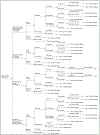Cost-Effectiveness of Strategies to Identify Children with Perinatally Acquired Hepatitis C Infection
- PMID: 37023948
- PMCID: PMC10448738
- DOI: 10.1016/j.jpeds.2023.113409
Cost-Effectiveness of Strategies to Identify Children with Perinatally Acquired Hepatitis C Infection
Abstract
Objective: To determine the optimal testing strategy to identify children with perinatally acquired hepatitis C virus (HCV) infection.
Study design: We used a decision-tree framework with a Markov disease progression model to conduct an economic analysis of 4 strategies, based on combinations of type and timing of test: anti-HCV with reflex to HCV RNA at 18 months among children known to be perinatally exposed (ie, baseline comparison strategy); HCV RNA testing at 2-6 months among infants known to be perinatally exposed (test strategy 1); universal anti-HCV with reflex to HCV RNA at 18 months among all children (test strategy 2); and universal HCV RNA testing at 2-6 months among all infants (test strategy 3). We estimated total cost, quality-adjusted life years, and disease sequalae for each strategy.
Results: Each of the 3 alternative testing strategies resulted in an increased number of children tested and improved health outcomes. HCV RNA testing at 2-6 months (test strategy 1) was cost-saving and resulted in a population-level difference in cost of $469 671. The 2 universal testing strategies resulted in an increase in quality-adjusted life years and an increase in total costs.
Conclusions: Testing of perinatally exposed infants at age 2-6 months with a single HCV RNA test will reduce costs and improve health outcomes, preventing morbidity and mortality associated with complications from perinatal HCV infections.
Keywords: diagnosis; economic evaluation; hepatitis C virus; maternal antibodies.
Copyright © 2023 The Author(s). Published by Elsevier Inc. All rights reserved.
Conflict of interest statement
Conflict of Interest Disclosures:
Author EWH reports receiving consulting fees from Merck & Co. for work unrelated to this research. All other authors have no conflicts of interest to report. LP, NN, CW, and ALS report salaries as employees at the US Centers for Disease Control and Prevention.
Figures


References
-
- CDC. Viral hepatitis surveillance—United States, 2020. Atlanta, GA: US Department of Health and Human Services, Centers for Disease Control and Prevention; 2022.
-
- Tovo PA, Pembrey LJ, Newell ML. Persistence rate and progression of vertically acquired hepatitis C infection. European Paediatric Hepatitis C Virus Infection. J Infect Dis. 2000;181:419–24. - PubMed
Publication types
MeSH terms
Substances
Grants and funding
LinkOut - more resources
Full Text Sources
Medical

